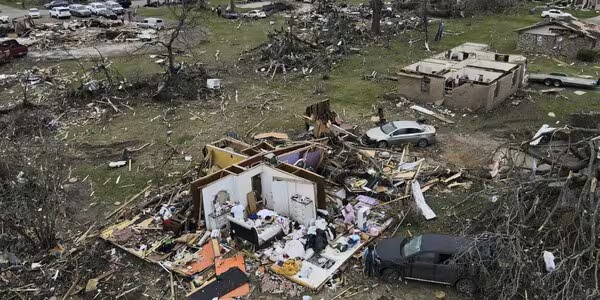A new wave of severe storms swept across Texas and the southern Plains on Tuesday, adding to the devastation caused by a series of deadly storms over the holiday weekend. These recent storms have left at least 22 people dead and have caused widespread power outages and significant damage.
Storms Bring New Destruction and Power Outages
The National Weather Service warned that the warm, moist air responsible for this unusually active tornado season would continue to fuel severe weather in the central U.S. throughout the week. Tornadoes and thunderstorms are expected to pose a threat across the Plains region, bringing with them heavy rains and potentially dangerous conditions.

As of Tuesday morning, more than 750,000 homes and businesses in north-central Texas were without power. Dallas County, the second most populous county in Texas, reported the highest number of outages, with over 390,000 utility customers in the dark. Weather officials issued tornado and thunderstorm advisories for the Dallas and Fort Worth areas, warning of winds exceeding 70 mph and urging residents to take cover and stay off the roads.
At Dallas Fort Worth International Airport, the storms led to the cancellation of over 160 flights and delays of more than 400. School districts across north-central Texas canceled classes or delayed openings, and the University of Texas at Dallas closed its campus until noon for damage assessment.
Heat Wave Aggravates Conditions in the Southern U.S.
Meanwhile, an intense heat wave has been affecting the Gulf Coast and parts of southern Texas. The National Weather Service reported “feels like” temperatures reaching up to 115 degrees. Central and southern Florida also experienced near-record high temperatures, with Melbourne and Fort Pierce recording 98 degrees on Memorial Day, setting new daily records and matching historic highs.
Cleanup and Recovery Amid Severe Weather Threats
The recent storms followed a weekend of deadly weather that left over 20 people dead and caused significant damage to homes and infrastructure. Arkansas, Texas, Kentucky, and Oklahoma were particularly hard hit, with tornadoes toppling trees, overturning cars, and flattening buildings. Texas alone saw at least 200 homes and buildings destroyed and another 120 damaged over the weekend.
Earlier in May, severe storms in the Houston area killed eight people, and a tornado in Temple, Texas, caused multiple injuries. Additionally, a deluge in eastern Texas led to historic river flooding and the tragic death of a 4-year-old boy.
Texas Governor Greg Abbott has issued a disaster declaration that now includes 106 counties. “The hopes and dreams of Texas families and small businesses have been crushed by storm after storm,” Abbott said in a statement. As of Tuesday morning, tens of thousands of homes and businesses remained without power across several states. Kentucky reported over 81,000 outages, Arkansas had 39,000, West Virginia 22,000, Missouri 21,000, and Virginia 11,000.
Looking Ahead: Continuing Threats and Recovery Efforts
The National Weather Service has warned that storms will continue to pose threats across the Plains, with heavy rain and scattered flooding expected. As the storms move eastward, they are anticipated to decrease in intensity.

The combination of severe weather and extreme heat presents ongoing challenges for residents and utility workers in the affected areas. Efforts to restore power and clean up debris are underway, but the continued threat of storms means that the situation remains precarious. Residents are advised to stay informed about weather updates and to take necessary precautions to stay safe.
